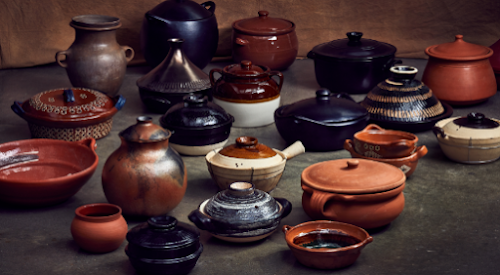Best Cooking Ware! (Audio inside)
मातीची भांडी - "जुनं ते सोनं". It is very true. let's talk about why we should use clay pots for cooking our food.
Welcome, we are going to talk about better cooking ware. I remember not until recently; the clay pots only used to come out of closets for cooking Biryani or Chicken dishes at home to give it an earthy flavour. After researching and reading about best cooking ware options, sharing the insights with you all. After reading the benefits, I am confident you too will move to basics like us.
In the olden times, people in rural India along with storing water in earthen pots also used them for cooking. Due to modernisation, ease of operation and continuous bombarding of advertisements, our kitchens are hijacked with non-stick and other metal utensils; earthenware is barely used. You all will agree with me that our grandparents or great grandparents lead a healthy life than us. Not only they were blessed with good quality food, but they were also blessed with best cooking ware.
During my childhood, I remember we use to have a clay pot “Mataka (as called in Marathi)” at our house. Not only the Mataka kept the water cool but I remember my grandmother used to tell me that “it acts as a filter and adds additional nutrients to the water”. Recently I read somewhere that water stored in clay pots is gentle on the throat and hence it is ideal for anyone who suffers from throat infections.
Ayurveda also suggests cooking in earthenware is much better than other utensils as it not only provides health benefits but increases the flavour and nutrition value of the food. The most compelling reason to start cooking in unglazed earthen pots comes from the one thing is that food does not react with pure clay and no toxic products are leached into our food.
You can get the earthenware in different shapes and sizes without really making a hole in your pocket. My recommendation is that you have separate pots for sweet and other dishes.
Let us understand the benefits point by point:
- The porosity and natural insulation properties of clay cause heat and moisture to circulate throughout clay pots which keeps the nutritional value of food intact. Because of slow cooking, the food does not require much attention. Trust me, we are very lucky to be born in India as the soil in India has around 18 important nutrients like calcium, iron, magnesium, sulphur, silicon, etc. The important reason behind this is we have an ample amount of sunlight throughout the year. So, cooking in earthenware provides these nutrients if missing.
- Ayurveda says that as clay is alkaline it neutralizes the acid in the food while making the food easy to digest. If the food is not that acidic, then clay pot adds a natural sweetness to the food.
- Due to its heat resistance and slow cooking, the food retains all its oils and moisture; therefore, the amount of oil or fat used for cooking is minimized.
- Using earthenware is environmentally friendly. They are completely biodegradable as they are made from a natural substance.
Difficulties of Cooking with Earthenware:
- It cannot be used for shallow or deep frying. You can use brass or bronze for frying which is still much safer and better solutions for cooking.
- There are a lot of glazed or polished earthen pot available in the market which must be completely avoided.
- Clay can break easily if you accidentally drop it. Also, sudden temperature extremes can cause clay pots to crack.
- Clay pots may be difficult to handle, especially when they are hot.
Instructions to use them:
- Soak the new cookware in water overnight. The pores of the pot will absorb the water and later adds this moisture to the food while cooking.
- Always cook on low to medium heat as extreme temperatures may cause cracks to the earthenware. But when my wife makes chapati/bhakari on the tawa, she makes it on the high flame after the tawa is heated on slow flames first.
- Before wash, soak the pot for a few minutes in warm water. Do not use soap or detergent to clean as the pot may absorb the soap particles. You can clean it with baking soda and wash off with warm water.
- Avoid adding cold water when the pot is hot.
- If you've accidentally overcooked or burned food, pour some warm water in the pot, sprinkle baking soda and let it sit for 10 minutes, scrub it slowly.



Thank you for giving the benefits and difficulties in using earthenware. Dahi sets very well in a clay bowl.
ReplyDeleteThanks Mimi, yes definitely!.Also, the blog is incomplete without the mention of #MishtiDoi, #Phirni, #Matka #Kulfi and #Chai being served in clay pots - #Kulhad.
DeleteNicely written and it was a pleasure to learn about #earthenware in this new era 😄
ReplyDeleteThanks Prajakta, Hope earthen ware makes an entry to your kitchen soon!
Delete